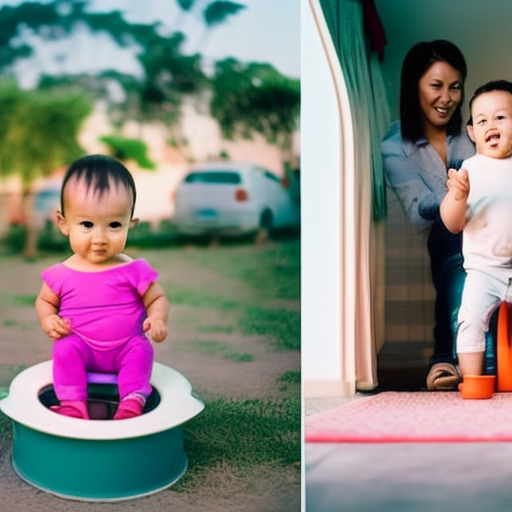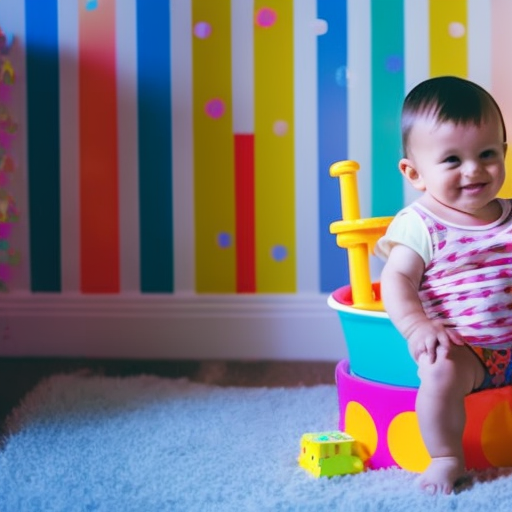"Cherishing Little Steps - A Haven for Baby and Family Journeys"
Potty Training Made Simple
Are you ready to tackle potty training head-on?
Did you know that the average child can be fully trained in just a matter of days? Yes, you heard that right!
With ‘Potty Training Made Simple,’ you’ll discover a step-by-step guide that takes the guesswork out of this important milestone.
No more stressful accidents or endless trips to the diaper aisle.
This guide is designed with you in mind, providing intimate and practical advice that will have your little one confidently using the potty in no time.
From setting the stage for success to overcoming common challenges, we’ve got you covered.
Say goodbye to diapers and hello to potty training success!
Key Takeaways
- Consider your child’s toilet readiness
- Establish a consistent potty training routine
- Use positive reinforcement to celebrate successes
- Be patient and understanding during regression phases
Essential Potty Training Supplies
To successfully potty train your child, you’ll need a few essential potty training supplies. One of the first things to consider is your child’s toilet readiness. Are they showing signs of being ready to use the toilet, such as staying dry for longer periods or expressing an interest in the bathroom? Once you determine their readiness, it’s time to invest in a portable potty.
A portable potty is a great tool for potty training because it allows your child to have their own designated space to use the bathroom. It can be easily moved around the house, making it convenient for your child to use whenever they feel the urge. Look for a portable potty that’s comfortable, easy to clean, and has a splash guard to prevent messes.
In addition to a portable potty, you’ll also need other supplies like training pants, wipes, and a step stool. Training pants are a great transition from diapers to underwear, providing your child with a sense of independence while still offering some protection against accidents. Wipes are essential for keeping your child clean and fresh during the potty training process. A step stool will help your child reach the toilet and wash their hands independently.
Setting the Stage for Success
Once you have gathered the necessary potty training supplies, it’s important to create an environment that sets the stage for success. Parental involvement and toilet training readiness are key factors in ensuring a smooth and successful potty training journey for your child. Here are three essential steps to help you set the stage for success:
-
Establish a routine: Consistency is crucial when it comes to potty training. Set a regular schedule for bathroom breaks, such as after meals or before bedtime. This helps your child develop a habit and anticipate when they need to use the potty.
-
Create a comfortable space: Make the bathroom a welcoming and child-friendly environment. Use a child-sized potty or a toilet seat reducer to ensure your child feels secure and comfortable while sitting. Consider adding some fun and engaging elements, like books or toys, to make the experience enjoyable.
-
Celebrate successes: Positive reinforcement plays a vital role in potty training. When your child successfully uses the potty, celebrate their achievement with praise, hugs, or small rewards like stickers or a special treat. This encourages them to continue their progress and builds their confidence.
Step-by-Step Potty Training Guide

Start by creating a clear and structured plan for potty training. It’s important to assess your child’s potty training readiness before beginning. Look out for signs such as staying dry for longer periods, showing interest in using the toilet, and being able to follow simple instructions. Once you feel your child is ready, establish a routine that includes regular trips to the bathroom. Encourage your child to sit on the potty at consistent times throughout the day, such as after meals or before bath time. Make sure to provide positive reinforcement and praise for any successful attempts.
However, it’s important to note that potty training regression is common and can happen at any time. Your child may have accidents or refuse to use the potty after showing progress. Stay patient and understanding during this phase. Revisit the basics, such as reminding your child to use the potty regularly and providing gentle reminders. Avoid punishing or shaming your child, as this can lead to setbacks. Instead, offer support and reassurance.
Overcoming Common Potty Training Challenges
If your child experiences potty training regression, staying patient and providing support is key to overcoming this common challenge. It’s important to remember that accidents happen, and it’s a normal part of the learning process. Here are three tips to help you deal with accidents and navigate nighttime potty training:
-
Stay calm and supportive: When accidents occur, it’s essential to remain calm and reassure your child that it’s okay. Avoid getting upset or scolding them, as this may create anxiety and hinder their progress. Instead, offer encouragement and remind them of their success in the past.
-
Establish a routine: Implementing a consistent potty training routine can be helpful, especially during nighttime training. Encourage your child to use the potty before bed and consider limiting their fluid intake in the evening. Wake them up at a designated time during the night to use the bathroom, gradually increasing the interval between wake-ups as they become more confident.
-
Use protective measures: Consider using waterproof mattress protectors and placing a potty chair or small portable toilet next to your child’s bed. This way, they’ve easy access to the bathroom during the night, reducing the chances of accidents. Additionally, using absorbent training pants or underwear designed for nighttime can provide extra protection.
Reward Systems and Positive Reinforcement

Implementing a reward system and using positive reinforcement can greatly enhance your child’s potty training experience. One effective strategy is to use behavior charts to track your child’s progress. A behavior chart is a visual tool that allows you to record your child’s successful bathroom trips. Each time your child successfully uses the potty, you can add a sticker or a checkmark to the chart. This not only motivates your child to continue using the potty, but it also gives them a sense of accomplishment as they see their progress.
In addition to behavior charts, verbal praise is another powerful tool for positive reinforcement. Whenever your child successfully uses the potty, make sure to shower them with praise and encouragement. Use specific and descriptive language to highlight their achievement. For example, you can say, ‘Great job, you did it! You’re becoming such a big boy/girl!’ This positive reinforcement will boost your child’s confidence and make them more eager to continue using the potty.
Transitioning to the Big Kid Potty
To ease the transition to the big kid potty, ensure your child’s comfort and confidence by gradually introducing them to their new toilet.
Here are three steps to help you navigate this important milestone:
-
Potty Training Readiness: Before introducing the concept of using the toilet, make sure your child is physically and emotionally ready. Look for signs such as showing interest in the bathroom, staying dry for longer periods, and demonstrating the ability to follow simple instructions.
-
Introducing the Concept: Start by familiarizing your child with the big kid potty. Let them explore and sit on it fully clothed to get comfortable. Explain that this is where they’ll now go potty like a big kid. Use age-appropriate books or videos to reinforce the idea and make it fun.
-
Gradual Progression: Slowly transition from diapers to training pants or underwear. Encourage your child to sit on the potty at regular intervals throughout the day, such as after meals or before bedtime. Praise their efforts and provide gentle reminders when needed.
Frequently Asked Questions
How Do I Know if My Child Is Ready for Potty Training?
Are you wondering if your child is ready for potty training? Look out for signs of readiness, like showing interest in the toilet and staying dry for longer periods. Here are some tips for successful potty training.
What Should I Do if My Child Is Resistant to Using the Potty?
If your child is resistant to using the potty, don’t worry, it’s normal. Stay calm and patient. Try different strategies like rewards, praise, or using a potty chart. Consistency and positive reinforcement will help them overcome this regression.
How Long Does Potty Training Typically Take?
On average, potty training usually takes a few months. But don’t worry, there are various methods you can try to make it easier for your child.
What Should I Do if My Child Has Accidents During the Potty Training Process?
If your child has accidents during potty training, don’t worry, it’s normal. Stay calm and supportive. Clean up accidents without making a big deal. Offer encouragement and remind them to use the potty next time.
How Can I Handle Nighttime Potty Training and Bedwetting?
To handle nighttime potty training and bedwetting, try limiting fluids before bed, using waterproof mattress covers, and encouraging your child to use the bathroom before sleep. Consistency, patience, and positive reinforcement are key.
Conclusion
So there you have it, potty training made simple!
With the right supplies, a supportive environment, and a step-by-step guide, you can overcome any challenges that may arise.
Remember to use reward systems and positive reinforcement to motivate your little one along the way.
And before you know it, they’ll be transitioning to the big kid potty with confidence.
Now, are you ready to embark on this exciting journey with your child?


